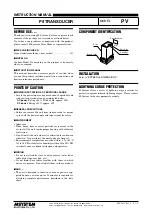
■
Changing the transceiver type for a trunked port without ensuring that the mode settings for
the port match other ports in the same trunk can result in a mode mismatch.
■
If STP is enabled on the switch, then changing the transceiver type for a port without
reconfiguring the cost or priority settings for that port can unfavorably affect how the switch
uses that port in the STP environment.
■
If the port was configured with non-default VLAN settings before changing transceiver types,
then you should ensure that these settings support your intended use of the port after
installing the new transceiver type.
Transceiver Changes and Switch Memory
Use the
write memory
command to save the current configuration to permanent memory (startup
config) if you want the switch to use the current hardware configuration after subsequent reboots.
Otherwise, you will be prompted with the following message (to save the configuration) the next
time you use the reboot or reload commands, or if you move from the CLI to the Menu interface:
Do you want to save the current configuration [y/n] ?
Note that if you exchange transceiver types in a module and reboot the switch, but do not save the
configuration, you can restore the switch to its prior configuration state by re-installing the original
transceiver type in the module and rebooting the switch again. This is because the switch operates
using the running-configuration, but reboots from the startup-configuration. For more information
on switch memory, including the startup-config and running-config memories, refer to the
Manage
ment and Configuration Guide
on the
Documentation CD-ROM
included with your switch.
For more information on transceivers and the transceiver module, see the documentation provided
with the transceivers and the module and also available on the
Documentation CD-ROM
provided
with your HP Series 4100gl Switch. For the latest version of HP switch documentation, visit
http://www.hp.com/go/hpprocurve
. (Click on
technical support
, then
Product manuals
.)
Transceiver Configuration Notes
N o t e
In the following text, any mention of negotiation of “flow control” assumes that flow control is
Enabled
for the port, which allows the negotiation. In the default configuration, flow control is disabled, but
can be enabled through the switch console.
Default Configuration for Transceivers.
The default configurations for the following high-speed
transceivers, which can be installed in your Series 4100gl Switch, are as follows:
■
Gigabit-SX and Gigabit-LX transceivers —
Auto
. The speed and communication mode are set
at 1000 Mbps and full duplex, according to the standards, and the switch auto-negotiates
flow control with the connected device.
■
100-FX —
100/Full
. The port has a fixed configuration of 100 Mbps, full duplex.
5


























